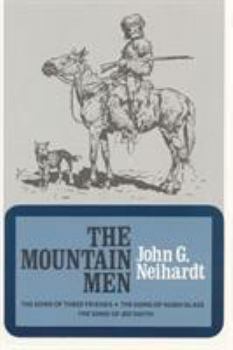The Mountain Men (Volume 1 of a Cycle of the West)
Select Format
Select Condition 
Book Overview
The first volume in this two-volume edition of A Cycle of the West includes The Song of Three Friends (1919), which received the National Prize of the Poetry Society of America, The Song of Jed Smith (1941). The first two songs, in the poet's words, "deal with the ascent of the river and characteristic adventures of Ashley-Henry men in the country of the upper Missouri and the Yellowstone. The Song of Jed Smith follows...
Format:Paperback
Language:English
ISBN:0803257333
ISBN13:9780803257337
Release Date:June 1971
Publisher:Bison Books
Length:369 Pages
Weight:0.90 lbs.
Dimensions:0.9" x 5.0" x 8.0"
Customer Reviews
2 ratings
Superb Technique
Published by Thriftbooks.com User , 19 years ago
I had the good fortune to meet Dr. Neihardt when I was 15. We had been discussing poetry in my high school literature class, focusing on meaning in the poetry we read. I asked Dr. Neihardt what he considered the most important thing in writing poetry, expecting to hear something about philosophy or emotion or, at least, meaning. "Technique," he answered. As I look at his work I can see what he meant. His magnum opus, A Cycle of the West, is an example of the finest of the writing art. In keeping with his view that poetry is a vocal art and with his background of absorbing Homer in the Greek and Virgil in the Latin as a kid, he titles the five divisions of the work as songs: The Song of Three Friends, The Song of Hugh Glass, The song of Jed Smith, The Song of the Indian Wars, and The Song of the Messiah. Dr. Neihardt adopted a rule to apply throughout his work: the entire work would be in iambic pentameter with rhymed couplets. The entire work, properly termed an epic poem, required faithful daily application for thirty years of his life. On some of those days he could progress only five lines. He described to me how he often had to revise whole hard-won sections he thought he had gotten to be good but on the next day's review, weren't. One should not forget the difficult research Neihardt had to do, too. Travel in the early 1900s was very difficult, and Neihardt covered thousands of miles to get his material for the Cycle. All the advice one reads from Strunk and White, Barzun, and others is reflected in every sentence of the Cycle. Every word does all the work that can be gotten out of it. The reader is placed on scene in every sentence. Scene, description, and summary are subtly blended everywhere. The passage of time is also smoothly handled. Neihardt achieved mood through technique. He would often select dark and bright words as needed. He used every rhetorical tool. One will not find inert material anywhere, either. The extremely few adverbs and adjectives Neihardt allowed into his work are indispensable, and each one is there to take the place of many words. Beyond this, though, the Cycle fulfills its job of allowing for a captivating, smoothly flowing recital aloud. The reader will stumble on no clumsy wording. An example from the end of his Song of the Indian Wars, where Crazy Horse is taken off to be buried by his parents: "And when the morning heard the meadowlark/ The last great Sioux rode silently away./ Before the pony drag on which he lay/ An old man tottered. Bowed above the bier,/A little wrinkled woman kept the rear/ With not a sound and nothing in her eyes./ (white space) Who knows the crumbling summit where he lies/ Alone among the badlands? Kiotes prowl/ About it, and the voices of the owl/ Assume the day-long sorrow of the crows,/ These many grasses and these many snows." Powerful stuff! It's all that good. Little wonder it was selected for inclusion in The Best Books of the World f
Outstanding poetic review of the white race's journey west.
Published by Thriftbooks.com User , 25 years ago
A true mystic's view, inspired by his subconscious, this rhymed couplet volume of five songs shows the process of the take over of the Native American lands. This recital of the facts and details of the westward expansion focuses on five distinct times, commencing with the Ashley-Henry expedition and culminating with the Native American "Ghost Dancers" attempt to return their lands to the people as a whole, rather than to individuals or companies.Neihardt neither praises nor condemns the expansion itself but shows how it occurred, warts and all. While sympathetic to the Native American cause, Neihardt judges neither the white man nor the Plains folk.Neihardt praises the beauty of the human form, spirit and tenacity. He sees the beauty underneath the blemishes that are all too obvious. He shows the power of perseverence in his song of Hugh Glass. He shows the love and jealousy of two men in the shooting of the cup. He shows the Native American subjugation through religion as no other writer could. His simple rhyming couplets that extend for five full length books, reveal the mystical relationship Neihardt had not only with Native Americans but also with the Earth and all of her denizens.From his early days as a Kansas farm boy to his later years as a professor of literature, Neihardt has sustained this objective but sympathetic view from the Native American's eyes.Only John Gneisenau Neihardt could hear the songs from the Wind, the Earth, the Moon, the Sun, the Spirits of the Fathers and Grandfathers that went before and then place them on paper, for those who cared to listen, to hear them.This compendium of information, data, insight and welt geist is not only accurate in detail but is also related in a gracious flowing poetry that, while beautiful on the page, also sings on the lips of the intuitive aloud reader.




